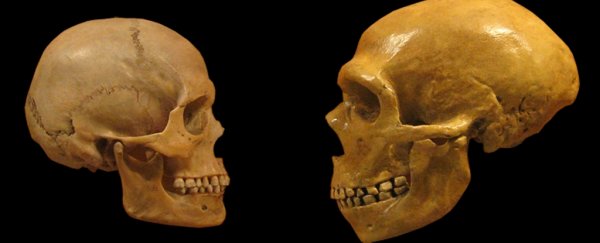Human beings were not always the docile, amiable and house-trained animals we are today.
Perhaps our ancestors were wild and ferocious, and only over time and by selecting more cooperative traits among ourselves, grew better at living and working with other humans in mutually beneficial communities, allowing the development of civilisation.
This is called the self-domestication hypothesis, and it's been around at least since Darwin's work on domestication published in 1868. There are lots of clues that seem to point to this, but now a team of scientists claims to have the first experimental evidence for it.
It lies, they said, in a gene that controls facial development. But to understand why the connection was made, first we have to talk about domesticated animals.
We humans have domesticated quite a few animals, selectively breeding them so that they are easier to live and work with - dogs, cats, and cattle, for example. And if you peer closely, these animals don't just differ from their wild counterparts in temperament and affability - they also look different.
These changes include shorter muzzles, smaller teeth, curly tails, floppy ears and more juvenile physiology.
These physical changes are collectively known as "domestication syndrome," and they've been tied to a deficit of genes in a cluster of cells called the neural crest during embryonic development.
These cells are responsible for, among other things, the development of the face. Since these changes are only seen in domesticated animals, it seems that the genes responsible for them could also be implicated in the personality changes that are involved in domestication.
Things get interesting when you perform the same comparison between human skulls and those of other hominids, such as Neanderthals. Similar differences are apparent. Our skulls are smaller, more juvenile-looking, with less prominent brow ridges.
In a 2017 paper, a team of researchers proposed that there might be a similar genetic mechanism at play in the neural crest in human development. So this is where a team led by molecular biologist Giuseppi Testa of the European Institute of Oncology in Italy conducted their investigation.
In a series of in vitro lab tests, the researchers focused on a gene that plays a key role in a developmental disorder called Williams-Beuren syndrome. People with Williams-Beuren syndrome have more childlike faces, and tend to be friendly, garrulous and trusting, completely non-aggressive.
They are also lacking (among other genetic abnormalities) one copy of a gene called BAZ1B, where people without the syndrome have two.
So, the researchers conducted tests to see what would happen when BAZ1B is altered.
They cultured 11 lines of neural crest stem cells, four from people with Williams-Beuren syndrome; four from people with its phenotypic opposite, with duplicated genes where they would be deleted in Williams-Beuren (and also opposite behaviours, such as selective mutism, social avoidance and physical aggression); and three from people with neither.
They then started tuning BAZ1B's activity up and down in each of these lines, and found that this had an effect on hundreds of genes associated with facial and cranial development. In particular, a slowed-down BAZ1B produced the facial features associated with Williams-Beuren syndrome.
This seems pretty consistent with a link between physical changes and friendly behaviour.
Next, they took a look at the genomes of our extinct relatives, Neanderthals and Denisovans, looking for differences in the genes regulated by BAZ1B between the species. And they found those genes in modern humans had a significant number of mutations not seen in the archaic hominids.
"We take this to mean that BAZ1B genetic network is an important reason our face is so different when compared with our extinct relatives, the Neanderthals," said biolinguist Cedric Boeckx of the Catalan Institute for Advanced Studies in Spain.
"In the big picture, it provides for the first time experimental validation of the neural crest-based self-domestication hypothesis."
The result isn't conclusive proof that humans self-domesticated, and it doesn't show how much BAZ1B contributed, if it did at all. If there is a genetic underpinning to self-domestication, it's likely that more than one gene is involved. But it is a very strong hint that this is a good line of enquiry to pursue.
"This research constitutes one of the first studies that uses cutting-edge empirical technologies in a clinical setting to understand how humans have evolved since the split with Neanderthals," Boeckx said, "and establishes Williams Syndrome in particular as a unique atypical neurodevelopmental window onto the evolution of our species."
The research has been published in Science Advances.
